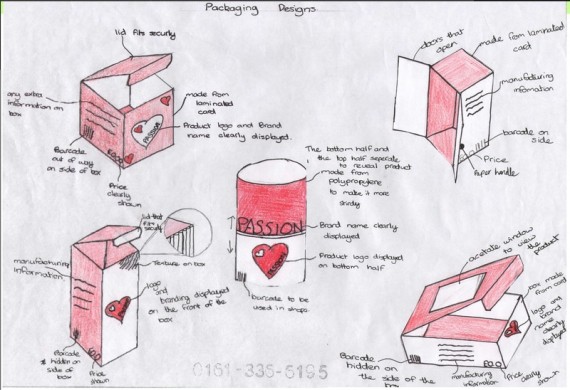
'Recognizing the need is the primary condition for design.'
Milton Glaser
Design your own packaging for a product of your choice
Task 1 - Choose a products to design packaging for. Use sketching techniques to produce an A3 sheet of initial design ideas in isometric view.
Task 2 - Annotate your design ideas adding constructional detial, e.g. how it foldes togeather, what materials you will use.
Task 3 - Discuss your desgin ideas with a peer and identify any improvements that could be made to your ideas, draw a final development of your designs in isometric view adding color and detail
Study the images below, what differances can you notice between your initial idea drawings and the development drawings shown below?
How are they drawn?
Is there more detail in the images and annotation?
How is color shown / indicated
How clearly are the surface graphic design ideas communicated?
Task 4 - Use 2D design to create a card box package for your choesn product, View the 2D design pages on this website if stuck, read the pointers below before you start)
Task 5 - Save your net as a JPG, open it in Photoshop and develop a graphic design that reflects your final drawn development using Photoshop Techniques
Packaging Design Pointers
In the retail market a great looking label, a unique container design or even the 'Made from recyclable materials' message, may just be the thing that hits a customer's 'buy' button. Packaging is all about promoting your product and how well it's done is critical to sales success. If you don't want to see your products languishing on the shelves, give them a critical appraisal with the following points in mind.
Does it stand out on the shelf?
Begin by looking at the packaging of similar items already on the market. Think about what your competitors have done and why they did it. Packaging can make a product stand out from its surroundings and that's definitely a marketing advantage. For smaller manufacturers, packaging is often the only 'advertising' their product receives. It can also be the only means they have of combating products with greater shelf space or more easily-recognized branding.
Does it meet legal requirements?
Packaging should be informative about what's inside. In many cases there are legal requirements governing what information must be stated - weight, materials used, whether the product is hazardous, where the contents originated and so forth. The same regulations may even specify the type sizes to be used and the location of these details on the package. Most countries have their own packaging standards and these must be followed if your product is being exported to them. Find out about these before you start the packaging design exercise.
Have you considered the buyer?
The packaging has to be targeted to the product's customers as carefully as any other promotional element. Are the buyers primarily male or female? Will they come from a younger or older age bracket? Are they likely to be sporty types or computer fanatics? Unless the packaging has a real visual appeal for your target audience, sales just won't happen.
Customers like to see what's inside the package, even if it's only a photograph of the product in use. Remember the old adage that ' A picture is worth a thousand words' - it gives you the chance to show your product at its best to the person thinking about buying it.
Does it tell them how to use it?
Many items are purchased on the basis of ease-of-use, so prospective buyers will often read the instructions on the package to see if there are any complicated procedures involved in getting the product to operate. Even if what's on the outside of the package is only an outline of more detailed instructions inside, or an assurance that it is easy to install or operate, it can provide a great degree of reassurance for the customer.
The package is also the place to put your product's guarantee. A 'satisfaction guaranteed or your money back' statement can be a significant purchasing incentive.
Does it protect the contents?
The package's physical construction is very important. The packaging is often all that protects the product and prevents it from being damaged in transit or while on the shelf awaiting sale.
The package has to be designed in such a way that its appearance won't be degraded by shipping and handling. Packaging can also help protect contents against temperature extremes, excessive humidity and moisture. So good packaging can save you a lot of wastage.







